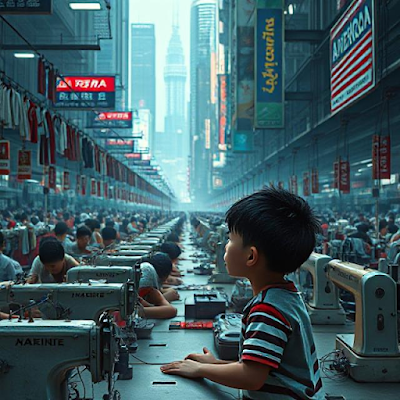How the States Have Made Us Poor: The Illusion of the American Dream and Its Global Impact
Introduction
For decades, the world has idolized the American Dream—a promise of prosperity, success, and a better life through hard work and determination. Youths across the globe look up to this ideal, hoping to achieve wealth and stability. However, the American Dream is a carefully crafted illusion, one that serves only those with access to power and resources, while keeping the rest in a vicious cycle of economic struggle. Worse still, this dream has not only failed many Americans but has also contributed to the impoverishment of other nations by creating artificial competition, economic disparity, and social division. The result? A generation lost in the pursuit of wealth at the cost of their dreams, values, and humanity.
The Reality Behind the Dream
The American Dream is not for everyone. It benefits only those close to financial and political power—those who are willing to sacrifice their morals to climb the economic ladder. The wealthiest individuals and corporations amass unimaginable riches while the working class and youth struggle to survive on stagnant wages and limited opportunities.The illusion is maintained through relentless propaganda, convincing people that if they work hard enough, they too can achieve success. In reality, the system is designed to keep the rich wealthy and the poor in servitude, living paycheck to paycheck, chasing an unattainable dream.
One of the most effective strategies used by the global economic elite is division—separating nations, communities, and even families in the pursuit of wealth. The world has been fragmented into countries and continents that compete for resources while a handful of nations, led by the United States, accumulate the lion’s share of global wealth. This division has created a world where:
- Resources are monopolized by the wealthiest corporations, leaving developing countries struggling with poverty and economic dependence.
- Workers are exploited across the globe, with multinational corporations paying meager wages while reaping enormous profits.
- Cultures are eroded, as traditional values and community-driven lifestyles are replaced by materialism and individualism.
How the American Dream Has Harmed Other Continents
While the American Dream paints a picture of opportunity, it has, in reality, harmed many countries in Africa, Asia, and Latin America. Let’s look at a few examples:
1. Africa: The Looting of Resources and Economic Dependence
African nations are among the richest in natural resources, yet they remain some of the poorest in terms of economic growth. Why? Because Western nations, led by the United States, have systematically exploited Africa’s wealth through neocolonialism. Multinational corporations extract oil, gold, and diamonds while the local populations suffer from poor wages, environmental destruction, and corrupt governments supported by Western interests. Countries like the Democratic Republic of Congo (DRC) are rich in minerals like cobalt, essential for American tech giants, yet the people remain in poverty, with child labor and warlords controlling the supply chains.
2. South America: Economic Sabotage and Political Instability
The pursuit of the American Dream has led the U.S. to interfere in Latin American economies, ensuring that these nations remain dependent on American policies and corporations. Countries like Venezuela and Chile have suffered economic crises fueled by U.S. sanctions and corporate exploitation. Venezuela, once one of the richest oil-producing nations, was crippled by economic warfare when it refused to align with American corporate interests. Similarly, U.S.-backed coups in countries like Chile (1973) and Guatemala (1954) ensured that leaders who prioritized their nations over American corporations were removed.
3. Asia: The Destruction of Local Industries and Labor Exploitation
The American corporate machine has turned countries like Bangladesh and India into factories for cheap labor. While American brands thrive, workers in these nations endure sweatshop conditions, earning meager wages while being denied basic rights. The outsourcing of jobs from America to these regions has not led to economic prosperity but to a cycle of exploitation where labor is cheap, and profits flow back to Western investors.
The Youth Crisis: Trapped in a System That Doesn't Serve Them
With the American Dream dominating global aspirations, youth worldwide find themselves trapped in a system that prioritizes money over purpose. Consider these harsh realities:
- Unemployment rates are at historic highs, pushing young people into crime, drug abuse, and depression.
- Education has become a business, where students graduate with massive debt and limited job prospects.
- Relationships suffer, as money replaces love, and true human connection is lost in the pursuit of wealth.
- Mental health crises are skyrocketing, with young people feeling hopeless in a world that measures their worth by their bank accounts.
The True Cost of Wealth: A Moral and Spiritual Decline
Money was never meant to be the ultimate goal of life. It is merely a tool, yet today, it has become the driving force behind human interactions. The pursuit of wealth has destroyed families, severed the bond between fathers and sons, mothers and daughters, and left societies fragmented. Those who achieve wealth often become slaves to it, losing their humanity in the process. They give not out of kindness but in expectation of favors and recognition. The rich look down upon the poor, labeling them as unworthy, yet it is often the poor who possess the true wealth of heart and spirit.
The Choice for the Youth: Breaking Free or Remaining Puppets
The youth of today face a critical choice—continue being puppets in a rigged system or break free and redefine success on their own terms. To do so, they must:
- Prioritize purpose over money – True success comes from fulfilling one’s passions, not just amassing wealth.
- Build local economies – Instead of chasing Western ideals, support and grow businesses within local communities.
- Reject materialism – Find happiness in meaningful relationships, creativity, and self-growth rather than consumerism.
- Educate themselves on economic systems – Understand how the global economy is structured to keep certain nations poor and work towards financial independence.
- Unite rather than compete – Stop fighting for scraps from the rich and instead collaborate to build sustainable futures.
Conclusion: A New Dream for the World
The American Dream has failed the world. It has created artificial divisions, economic slavery, and moral decay. It is time for the youth to wake up and forge a new dream—one that values humanity over money, purpose over profit, and unity over competition. The world doesn’t need more billionaires; it needs more people who are rich in wisdom, kindness, and integrity. Only then can we reclaim our lives and truly break free from the chains that the states have placed upon us.
The choice is ours.












Comments
Post a Comment